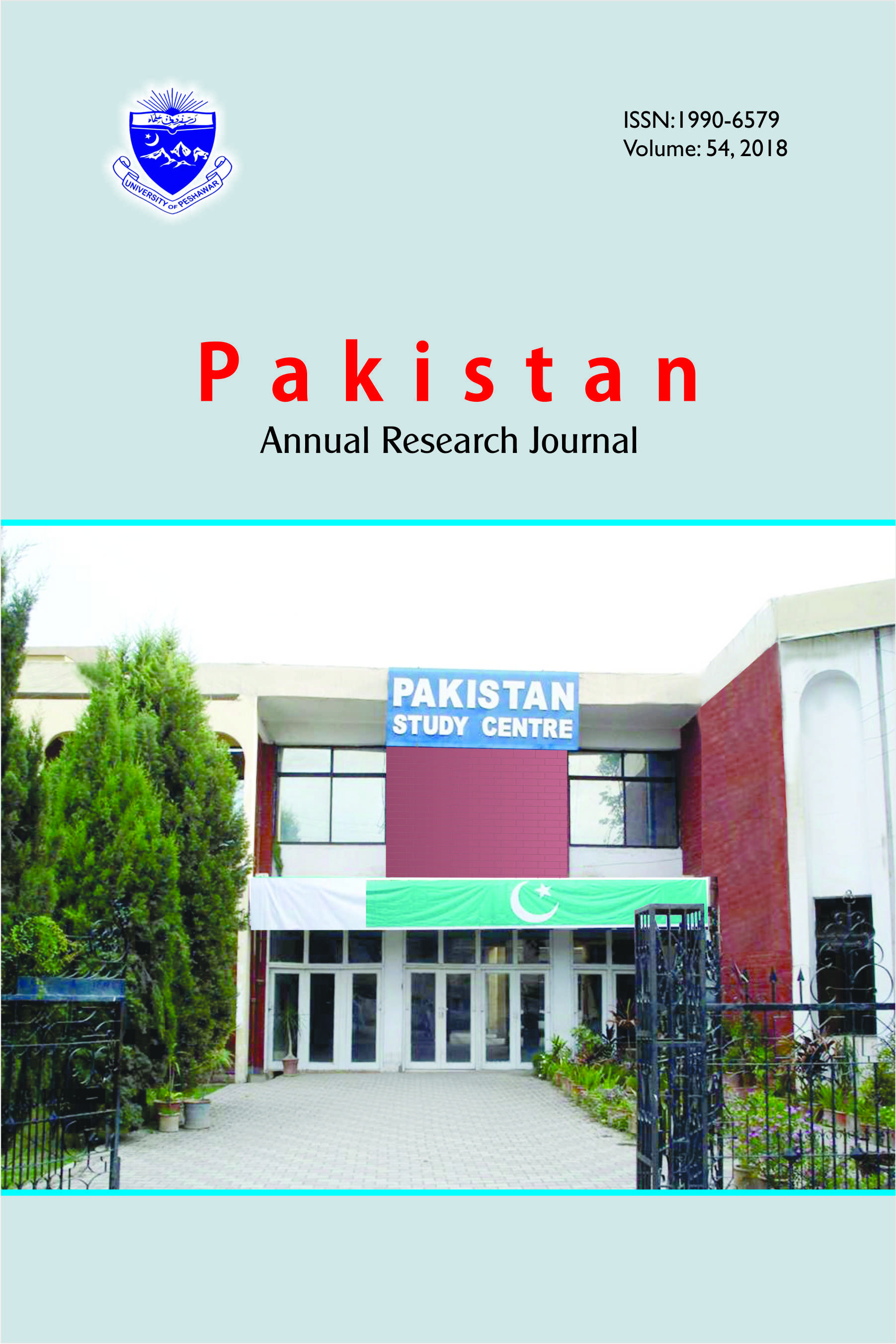EFFECTS OF DIGITAL MEDIA ON CULTURAL VALUES OF MALE UNIVERSITY STUDENTS OF PUNJAB, PAKISTAN
Keywords:
Digital media, University students, Cultural effectsAbstract
Due to rapid innovations and digital development, this world has becomea global village. Digital media is significant source of information and communication. Youth is heavy consumer of digital media. Frequently access to digital media without any boundaries imposes various effects. The basic aim of current research study is to know the effects of digital media on cultural values of male university students. Youth acts as symbolic representation of any society and to assess any cultural elements, university is the best place where freedom of gender brings significant changes. The Current study was conducted in public sector universities of Punjab Pakistan. It was survey based study and data was collected from 1300male students. Study was historically theme of “Social Learning Theory” and “Uses and Gratification Theory”. The study revealed that digital media has captured almost all the factors of life of students and proved itself vital part of lives. Furthermore, digital media is source of importing foreign culture and fading local culture among the youth of Pakistan.
References
Furedi F.How the internet and social media changing culture (2015). The
Aspen institute February 16, 2015 Education and culture. Retrieved from:
article/how_the_internet_and_social_media_are_changing_culture1, 2 accessed on 27-11-2017
Briggs A., Burke P. A Social History of the Media: From Gutenberg to the 3 Internet. Cambridge: Polity (2009).
Boyd D., Ellison N. B.Social network sites: definition, history, and 4 scholarship. J. Comp. Med. Commun. 13, (2007).210–230.
West J., Mace M. Browsing as the killer app: explaining the rapid success of 5 Apple's iPhone. Telecommunication Policy 34, (2010). 270–286.
Riaz S. “Effects of New Media Technologies on Political Communication”.Journal of Political Studies, Vol.1, Issue 2,
(2012).Pp.161-173.
Bakshy E., Hofman J. M., Mason W. A., Watts D. J.Everyone's an influencer,
inProceedings of the Fourth ACM International Conference on Web
Search and Data Mining - WSDM '11, ACM Press, New York, NY 7 (2011).
Aral S., Walker D.Identifying influential and susceptible members of social 8 networks. Science 337, (2012). 337–341.
Mathwick, C. Understanding the online consumer: A typology of online relational norms. Journal of Interactive Marketing, Vol.16, No.1,
(2002).Pp.40–55.
Arnold M. “Culture and Anarchy. The Complete Works of Matthew
”.Vol.5. The University of Michigan Press. (1965).
‐‐
Shabir G., HameedY.M.Y.,Safdar G., Gilani S.M.F.S. The Impact of Social
Media on Youth: A Case Study of Bahawalpur City. Asian Journal of Social Sciences & Humanities Vol.3(4).(2014).Pp.132-151.
Pakistan Culture National Curriculum for Pakistan Culture Grade XI-XII. Govt. of Pakistan. Ministry of Education Islamabad.(2011) Retrieved on 27-11-2017 from
http://pctb.punjab.gov.pk/system/files/Pakistan%20Culture%20XI_XII.pdf Allama Muhammad Iqbal, The Reconstruction of Religious Thought in Islam,
Sheikh Muhammad Ashraf, Lahore, (1965). p. 73
Arnold
Geerth D. H., Hofstede“Culture’s consequences: international differences in
work-related values”. SAGE. London.(1984).
Campbell D. E. “Choosing Democracy, 2nd ed.” Englewood Cliffs, NJ:
Prentice Hall. (2000).
Banks J. “Teaching Strategies for Ethnic Studies, 5th ed.” Englewood Cliffs,
NJ: Prentice Hall.(1984).
Marshall, P. L. Cultural Diversity in Our Schools. Belmont: Wadsworth.
(2002).
Clavert F. and Noiret S., “Digital Humanities and History. A New Field for
Historians in the Digital Age,” in Contemporary History in the Digital Age, ed. Ibidem (Brussels: Peter Lang, 2009), 15–26; ed. David M. Berry, Understanding Digital Humanities (Houndmills: Palgrave Macmillan, 2012); Susan Schreibman,A Companion to Digital
Humanities (Malden: Blackwell, 2004).
Weller T. “Introduction,” in History in the Digital Age, ed. Ibidem . London: 19 Routledge.(2013).
Prescott A. “An Electric Current of the Imagination: What the Digital Humanities Are and What They Might Become,”Journal of Digital
Humanities Vol.1, No. 2.(2012).
Groesen M. V. “Digital Gatekeeper of the Past: Delpher and the Emergence
of the Press in the Dutch Golden 21 Age,” TijdschriftvoorTijdschriftstudies Vol.38. (2015).Pp.9-19.
Acerbi A.A Cultural Evolution Approach to Digital Media.Frontiers in 22 Human Neuroscience.10(2016).636.
Hasebrink U., Jensen K.B.,Bulck H.V.D., Holig S., Maeseele P. Changing Patterns of Media Use Across Cultures: A Challenge for Longitudinal Research. International Journal of Communication. Vol. 9, (2015).
Pp.435–457
Tanvir S., ShovoT.A.,Mohsin K.F.“Cultural Globalization andShifting the
Cultural Identity of Youth: Satelite TV Perspective”. Bangladesh Research 24 Publication Journal Vol.10, No.1.(2014). Pp. 01-24.
Joag S. G. “Impact of the digital technology on Culture: Lessons from a Pilot Study”.Paper presented article in Global Awareness Society International
21st annual conference New York City. (2012).
Adegbiji M.,V. B, Oladimeji O., Abayomi O. G. “The use of internet by
ed. Ibidem (Brussels: Peter Lang, 2009), 15–26; ed. David M. Berry, Understanding Digital Humanities (Houndmills: Palgrave Macmillan, 2012); Susan Schreibman,A Companion to Digital
Humanities (Malden: Blackwell, 2004).
27 28
undergraduate students in selected universities in Nigeria”. Global Media Journal Pakistan Edition. Vol.5, No.2. (2012).
Ayesha A., Sajida R. “Vulnerability of cultural values in the era of information communication technology”. The Explorer: Journal of social sciences. Vol.1, No.3.(2015). Pp.78-81
Ali, Khalid & Hassan “Impact of Indian dramas on language and dressing of females of village Sehowal, Sialkot”.Online journal of Communication and Media Technologies. Vol.5, No.1.(2015). Pp.159-173.
Juni M. S. “Impact of Global Media on the Culture of Pakistan: A Case Study of Youth of Layyah City”. International Journal of Innovation and
Applied Studies. Vol. 8, No.3.(2014). Pp. 1008-1014
Moazzam N., ManjY.N.,Riaz F., Awan K.A., Siddique A., Shahzadi S.,
Ahamd T., Ahmad Z. “Exposure to foreign media and changing in cultural traits- A study conducted in District Sargodha and Multan”. Scholars journal of arts, humanities and social sciences. Vol. 2, No.4B.(2014).
Pp.563-570
Naseer M., Nawaz Y, Azhar Z., Andleeb Z., Ahmad U., Riaz F. “A
Sociological analysis of cultural imperialism of international media on Pakistani youth”.Mediterranean Journal of Social Sciences. Vol.5, No.3. (2014). Pp.523-532.





